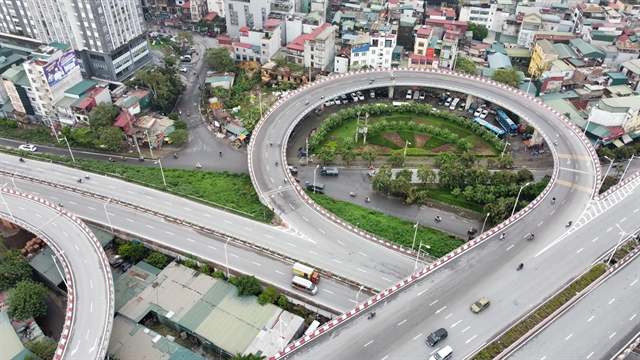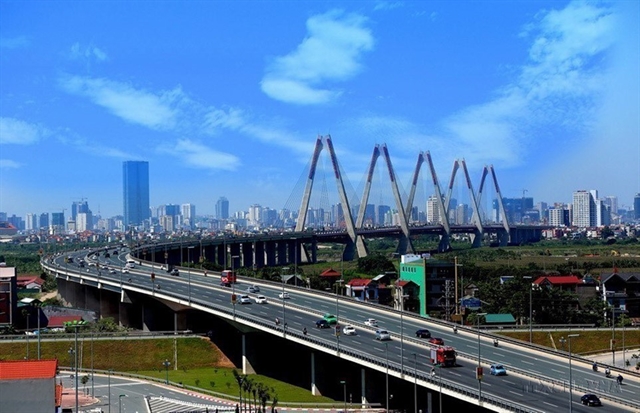 Society
Society

 |
| SUPER HIGHWAY: The road leading from Nguyễn Khoái dike to Vĩnh Tuy Bridge in Hà Nội. VNA/VNS Photos |
Recent investments in Hà Nội’s transport infrastructure have significantly enhanced convenience for residents and catalysed urban growth. A wide range of projects, including expressways, ring roads, regional connectors, and bridges over the Hồng and Đuống rivers, have been developed, forming a more integrated transport network for the city.
Upon completion, these developments have not only shortened travel times, but also alleviated traffic congestion and supported the city's expansion into new urban spaces.
Infrastructure shaping urban growth
According to the Hà Nội Department of Transport, the city has fully completed key motorway projects totalling 111km, along with national routes that have been developed and are now operational. Additionally, work is advancing on seven ring roads, which are gradually being constructed and nearing completion.
Presently across the Hồng River are nine bridges: Thăng Long, Chương Dương, Thanh Trì, Vĩnh Tuy, Nhật Tân, Vĩnh Thịnh, Văn Lang, Trung Hà, and Long Biên. Meanwhile, six new bridges are undergoing final procedures for construction, including Tứ Liên, Hồng Hà and Mễ Sở.
Regarding the Đuống River, four of the eight planned bridges have been completed: Đuống, Phù Đổng 1 and 2, and Đông Trù. Currently, the new Đuống Bridge is under construction, while the remaining three bridges—Giang Biên, Mai Lâm and Ngọc Thụy—are in the pipeline for development.
Beyond Ring Road 4, other key projects are being developed, including the Hoàng Cầu-Voi Phục section of Ring Road 1 and the upgrade of National Route 6 (Ba La to Xuân Mai). An extension of Thăng Long Highway is also underway to connect Route 21 and the Hà Nội-Hòa Bình expressway.
To ease traffic congestion, the city built 12 flyovers at critical points, while underpasses at intersections such as Kim Liên-Xã Đàn on Ring Road 1, Thanh Xuân, and Lê Văn Lương-Ring Road 3 have improved traffic flow.
Additional underpasses will soon be constructed at the Cổ Linh interchange, along the Tây Thăng Long route crossing Ring Road 3, and at the Mễ Trì-Dương Đình Nghệ-Ring Road 3 junction.
There are also plans to expand key routes such as Ring Road 2 (from Ngã Tư Sở to Cầu Giấy) and Hoàng Quốc Việt Street (from Phạm Văn Đồng to Trần Vỹ Street), featuring a direct underpass through Phạm Văn Đồng.
Nguyễn Văn Hải, a resident of Thanh Xuân District, observed the rapid growth of Hà Nội’s transport infrastructure and how it has accelerated urban development.
 |
| CAPITAL CONNECTION: Nhật Tân Bridge in Hà Nội capital city – the largest cable-stayed bridge in Việt Nam spanning the Red River. |
“The city’s growing road network, including new lightweight flyovers and bridges, has greatly improved traffic flow and relieved congestion,” Hải said.
“Hà Nội’s historical charm, once characterised by the 36-street Old Quarter, is now complemented by modern expressways and bridges over the Hồng River, going beyond old icons like Long Biên Bridge and Thăng Long Citadel to include newer structures like the bridges of Thanh Trì, Vĩnh Tuy, Nhật Tân, Đông Trù, and Vĩnh Thịnh.”
Addressing bottlenecks
Despite this progress, Nguyễn Phi Thường, director of the Department of Transport, acknowledged that some strategic goals have yet to be fully achieved. The area designated for transport infrastructure currently covers only 10.35 per cent of urban land, falling short of the target of 20-26 per cent, and the land available for static transport is less than 1 per cent, compared to the goal of 3-4 per cent.
Connectivity between key intra- and inter-regional transport routes also remains insufficient. Several key sections of major roads, including Ring Roads 2.5, 3, and 3.5, are still under development, with full connectivity yet to be achieved.
Additionally, Ring Road 4 is still in the investment phase, and many main routes linking central Hà Nội to its satellite towns continue to rely on existing national highways.
One major challenge in completing these projects is funding. Only 20 per cent of the required budget is covered by the city, with 80 per cent expected from private investment. Land clearance difficulties and a lack of policies incentivising investment also continue to delay progress.
To address these issues, Hà Nội is revising its transport infrastructure plans to align with its broader urban development strategy. Key projects such as ring roads and highways, along with the construction of new bridges, are expected to boost regional connectivity and promote the growth of satellite towns.
Future developments will see major roads linking the city centre to satellite towns widened to between 40 and 60 metres, with a minimum of six lanes.
Key routes include Tây Thăng Long (connecting Ring Road 4 to Sơn Tây satellite town), West Lake-Ba Vì (from Ring Road 4 to Hòa Lạc satellite town), Hà Đông-Xuân Mai, and Ngọc Hồi-Phú Xuyên.
Strategic focus for future growth
To realise these goals, Hà Nội is prioritising three strategic breakthroughs.
First, the city aims to develop an integrated transport network connecting the inner city with its suburbs, satellite towns, and regional provinces. Second, it plans to enhance its digital infrastructure and data systems to support the digital economy and social development. Lastly, the focus will be on accelerating critical transport projects for each development phase.
Each year, half of Hà Nội’s investment resources are allocated to transport infrastructure, creating better conditions for expansion. Urban transport programmes have steadily improved, increasing in quality with each term.
The city has also received strong government backing to collaborate with surrounding provinces to fund and build Ring Road 4, a key inter-regional route that is vital for both socioeconomic development and national security within the capital region.
“During implementation, the city will continuously review and prioritise urgent infrastructure projects for focused investment. We will ensure clear guidelines on investment methods, funding, and timelines to achieve these strategic goals,” Director Thường said. VNS